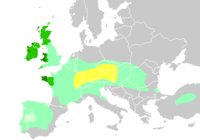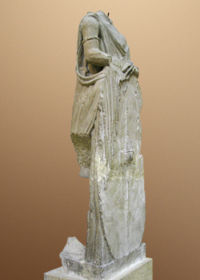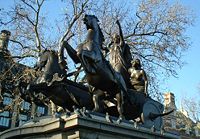Wikijunior:Ancient Civilizations/Celts
What country did they live in?
[edit | edit source]
In around 400 BC, the Celts ranged from Britain and Ireland all the way across Europe to northern Turkey. Today, Celtic descendants live in Scotland, Wales, Cornwall and Northern Ireland in the United Kingdom, Brittany in France, the Isle of Man and the Republic of Ireland. Other Celtic people live in countries where their ancestors moved to.
What did they look like?
[edit | edit source]Men wore a loose fitting tunic down to the knees and trousers called Bracae. Women wore long, loose fitting dresses. They made their clothes from linen woven from the flax that Celtic farmers grew. They were very concerned about their appearance and used dye from berries to colour their clothes. Both men and women also wore great cloaks when travelling, women used a decorative brooch to fasten their cloak at the neck. These cloaks were very heavy and often used as sleeping bags for the men when they were away hunting. The Celts used lime to bleach their hair, preferring light hair and both men and women wore their hair long.
What did their buildings look like?
[edit | edit source]Most Iron Age Celts in Britain lived in roundhouses; circular houses of wood or stone with thatched straw roofs shaped like a cone. Most roundhouses were made up of wooden posts, with the walls made out of "wattle and daub." Wattle and daub consists of wooden sticks (wattles), covered with a mixed mud and clay plaster (daub).
In Scotland most roundhouses were built of stone rather than wood, yet retained the cone-shaped thatched roof. This type of roundhouse is called the Atlantic roundhouse.
Celtic houses in mainland Europe were rectangular.
The Celts in Ireland built many forts and settlements, the most popular design was the ringfort. Inside a ringfort wooden, circular houses were built using wattle and daub.
Celts also built fortified defensive structures, which can still be seen today, especially in the highlands and isles of Scotland, as well as Ireland.
What did they eat?
[edit | edit source]Celts ate like most other Europeans, subsisting mostly on grains supplemented by meats, fruits, and vegetables. Exactly what they ate varied by area, and Celts grew local crops. Scottish highlanders were famous for supposedly subsisting almost entirely on oats, though this was not entirely true. However, oats remain the favorite grain of Scotland, and Scottish cuisine is full of them. Potatoes serve this role in Ireland, although they were not introduced until after Columbus reached the New World.
The Celts in Ireland farmed the land and reared cattle and sheep. In the spring, they would get milk, butter and cheese from the cattle, killing them later in the year for meat. Cattle were not only a means of food for Celts, the Celts wealth was measured in the amount of cattle they owned. One ancient Irish tale tells of Queen Maedhb (May-ev) and another rival king, and their battle over the Táin Bó Chuaille (a bull). This doesn't just show the importance of cattle in Celtic society, but also the fact that they thoroughly accepted the idea of women as leaders, unlike other societies of that time.
The most famous example of food of any Celtic people is probably the Scottish haggis. Many people aren't quite clear on what a haggis is, and one survey conducted in the United States found that over half of the people they surveyed thought that the haggis was a small rodent native to Scotland. In reality, a haggis usually consists of a sheep's 'pluck' (heart, liver, windpipe and lungs), minced with onion, oatmeal, suet, spices, and salt, mixed with stock, which is traditionally boiled in the animal's stomach for about an hour.
What did they wear?
[edit | edit source]

Celts took a great interest in their clothes when they could afford to do so. Many more modern Celts had colourful designs woven into their clothes called tartan, still shown in Scottish Kilts and Trews today.
Celts also had a great fondness for jewellery, and both men and women wore quite a bit, when they could afford it.
Finally, many warrior Celts wore their weapons (swords, more often than not) as normal attire. This became very complex during the late Middle Ages with Scottish highlanders, who were sometimes seen with a broadsword at their waist, dirk (long knife) on their belt, one or more pistols also attached to their belt, a long hunting rifle, and a small dagger in their sock, called a Sgian Dubh (Gaelic for "Black Dagger").
What did their writing look like?
[edit | edit source]Celts didn't have a very high opinion of the written word. Instead, they recorded their history and culture in an oral tradition; that is, they recorded their past by telling stories. Early examples of Gaelic Celtic writing have been recovered in Europe, based on the Phoenician alphabet.
In Ireland, a different alphabet was used, primarily in Gaelic Celtic languages like Irish, Manx, and Scottish Gaelic. This alphabet was called Ogham, sometimes referred to as the "Celtic Tree Alphabet." It developed as a way for Irish monks to write in stone.

After Christianity was spread throughout the Gaelic world, Ogham fell into disuse, in favor of the Latin alphabet (largely because Christian writings were all in the Latin alphabet).
What did they believe?
[edit | edit source]Celts were polytheists; they believed in many gods and goddesses (deities). Unlike many other civilisations, different groups of Celts worshipped various deities, although there were some patterns. Beira was the name that Celts gave to Mother Earth, and some of them believed her to be the mother of all their deities.
Most Celts believed in an afterlife, we know this because archaeologists have found many grave goods within their burial tombs (Dolmens, Cairns). Many, though not all, Celts worshipped in sacred groves.
Are some of them famous even today?
[edit | edit source]

Yes! Today, the British Isles (along with Ireland) are probably regarded to be Celtic more than any other area in the world. No one is quite sure who lived there before them, and they were certainly well-established by the time the Romans came there in AD 43. After 20 years of Roman rule, the chieftain of the Icenii tribe, Prasutagus, died. Though by tradition, his wife Boudicca would have assumed leadership of the tribe, the Romans took Icenii land, brutally humiliating Boudicca and her two daughters. This enraged the Icenii people, and Boudicca raised an army to fight the Romans and liberate Britain. She gained support of many other Celtic tribes, and almost succeeded in toppling the Roman Empire in Britain. She is revered as a national hero in Britain.
The world-renowned Scottish poet, Robert Burns, was a Celt.
Many famous Celts are alive today. The famous Scottish actor, Sean Connery, is proud of his Celtic heritage.
What is left of them today?
[edit | edit source]Celts are alive and thriving today! Much of the population of Europe are seen as descendants of the Celts, and the nations of Scotland, Ireland, Wales, Cornwall, Brittany and Isle of Man are considered to be made up of primarily Celtic peoples. As well, the Celtic diaspora, the descendants of Celts around the world, is vast, being spread greatly through the British Empire. In particular, Nova Scotia, Canada, is a hotbed of modern Gaelic Celtic culture.